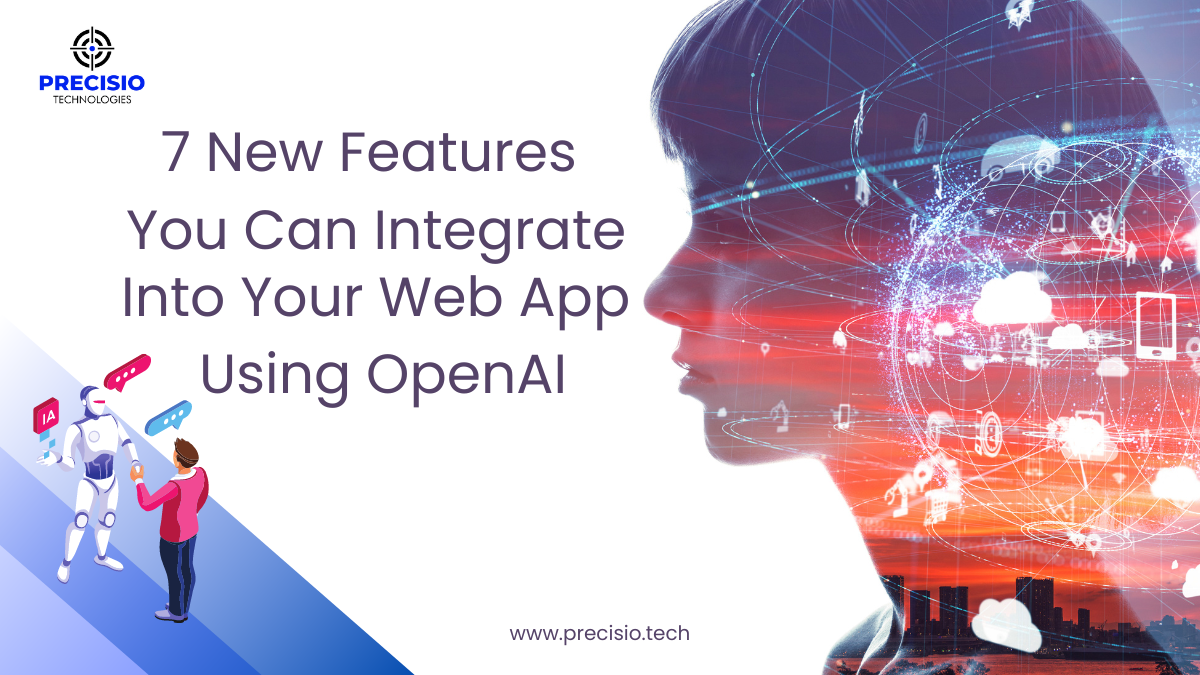
Enterprises are searching for new ways to improve their web applications every day to provide a better User experience (UX). In the present blog entry, we shall delve into seven popular functionalities that can be incorporated into your web application through the utilization of OpenAI.
The aforementioned attributes encompass natural language processing, image and video analysis, speech recognition, predictive analytics, fraud detection, virtual customer service, and intent recognition. Furthermore, we shall deliberate on the potential enhancements that OpenAI can offer to the intent recognition capabilities.
OpenAI is a cutting-edge technology that has revolutionized our perception of artificial intelligence. It possesses the ability to seamlessly incorporate novel functionalities into web applications, thereby enhancing their potency and efficacy. The present discourse endeavors to elucidate seven novel OpenAI features that can be seamlessly integrated into your web application. Additionally, we shall delve into the ways in which OpenAI can augment the capabilities of intent recognition.
-
Natural Language Processing
The Natural Language Processor is a subpart of artificial intelligence that helps for converting human language into machine language. With OpenAI, developers can use advanced NLP algorithms to process large amounts of text data, extract insights, and perform sentiment analysis. This can be easily used for chatbots, customer support systems, and content management platforms in a variety of web applications.
For example, a chatbot built using OpenAI’s NLP algorithms can understand the intent behind the user’s message and provide relevant responses or a content management platform can use NLP to automatically categorize and tag articles, making it easier for users to find relevant content.
-
Image and Video Analysis
OpenAI offers sophisticated image and video analysis capabilities that can assist developers in conducting real-time data analysis and visualization. With OpenAI’s image and video analysis capabilities, developers can build applications that can recognize faces, objects, and even emotions.
E.g. Video analytics platforms built using OpenAI can analyze customer behavior in real-time and provide insights on how to improve customer experience(CX).
-
Speech Recognition
Speech recognition is another powerful feature that can be integrated into web applications using OpenAI. OpenAI’s speech recognition algorithms, developers can build applications that can transcribe audio data in real-time, making it easier to automate customer support and call centre operations.
For example, a customer support platform built using OpenAI’s speech recognition algorithms can transcribe customer calls and automatically generate tickets, making it easier for agents to respond to customer queries.
-
Predictive Analytics
Predictive analytics can forecast future trends and identify potential risks. OpenAI’s predictive analytics capabilities can help developers build applications that can analyze large amounts of data with accurate predictions.
E.g. An e-commerce platform can use predictive analytics to recommend products based on customer browsing and purchase history.
-
Fraud Detection
Fraud detection is another important feature that can be integrated into web applications using OpenAI. With OpenAI’s fraud detection algorithms, developers can build applications that can detect fraudulent activities and prevent financial losses.
For example, a payment processing platform built using OpenAI’s fraud detection algorithms can analyze transaction data and flag suspicious activities in real time. Similarly, a banking platform can use fraud detection to prevent identity theft and other forms of financial fraud.
-
Virtual Customer Service
Virtual customer service is important as businesses want to provide 24/7 support to customers. With OpenAI’s virtual customer service capabilities, developers can build chatbots and voice assistants that can provide personalized support to customers.
For example, a chatbot built using OpenAI’s virtual customer service capabilities can answer common customer queries and provide real-time support. A voice assistant can be integrated into a mobile app, for using voice commands.
-
Intent Recognition
Intent recognition is a powerful tool that is used for understanding the intent behind a user’s message. With OpenAI’s intent recognition capabilities, developers can build chatbots and customer support systems that can provide accurate responses based on the user’s intent.
For example, a chatbot built using OpenAI’s intent recognition capabilities can understand the intent behind a user’s message and provide relevant responses. This can be extremely useful in a variety of web applications, including customer support systems and chatbots.
How OpenAI Can Improve Intent Recognition Capabilities
Advanced NLP Algorithms:
OpenAI’s advanced NLP algorithms can be used to analyze the user’s message and understand the intent behind it. These algorithms can also be used to identify the context of the message and provide relevant responses.
 Machine Learning Models:
Machine Learning Models:
OpenAI’s machine learning models can be trained on large datasets of customer interactions to improve the accuracy of intent recognition. This can help developers build chatbots and customer support systems that can provide more accurate and relevant responses to customers.
Contextual Information:
OpenAI’s algorithms can use contextual information such as user history, preferences, and behaviour to provide more personalized and relevant responses.
Continuous Learning:
OpenAI’s algorithms can be designed to continuously learn from customer interactions, which can help improve the accuracy of intent recognition over time. This can help developers build chatbots and customer support systems that can adapt to changing customer needs and preferences.
OpenAI offers developers a robust array of tools and capabilities that can be seamlessly integrated into web applications. From natural language processing to image and video analysis, OpenAI can help developers build more efficient and effective web applications. Additionally, OpenAI’s advanced algorithms and machine learning models can help improve intent recognition capabilities, leading to more accurate and personalized customer interactions.
Conclusion:
OpenAI has a wide range of powerful tools and capabilities. These tools can be integrated into web applications to improve their functionality and user experience. From natural language processing to intent recognition, OpenAI’s advanced algorithms and machine learning models can help developers build more efficient and effective web applications. Contact us today to learn more about the integration of OpenAI and its method, also do check our LinkedIn for the latest updates!

 Machine Learning Models:
Machine Learning Models: